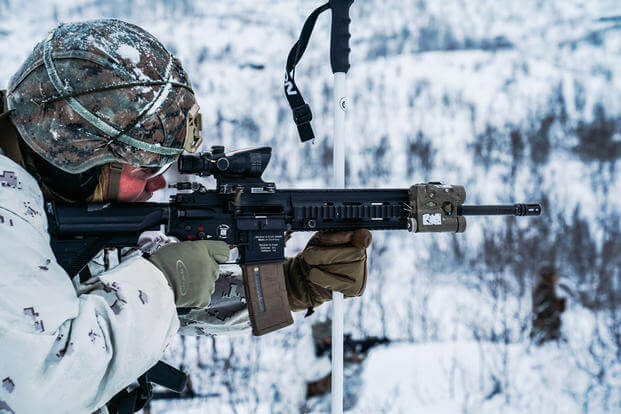Marine Corps equipment officials are looking for new extreme cold weather gear for combat units training to fight in subzero Arctic conditions.
Starting in late February, Marine Corps Systems Command began looking at the commercial cold weather gear market for new trigger finger mittens, base-layer long underwear and a hat that sounds like a modern version of the beloved GI pile cap, according to three request-for-information solicitations.
This latest search for better cold weather clothing -- long known as snivel gear in the ranks -- comes at a time when the U.S. military is intensifying its focus on the Arctic to counter potential aggression from Russia and China as melting ice is opening new sea lanes.
The Marines want ideas on a new USMC Trigger Finger Mitten System that will replace the current Extreme Cold Weather Mitten Shell & Liner, according to a March 3 solicitation. Trigger finger mittens offer the warmth of a mitten while featuring a separate trigger finger so combat troops can still fire their weapons.
"The trigger finger design shall enable the wearer to move their first finger independently from the rest of the hand, but if needed move their first finger into the larger finger compartment to warm up as needed," according to the solicitation.
The mitten shell should be constructed from a waterproof laminate with a water-repellent leather palm and feature a suede "nose wipe" on the back of the thumb, according to the solicitation. It should also be insulated and seam-sealed to provide full waterproofing.
The liner should fit easily into the shell, and the trigger finger should be constructed from leather for "enhanced dexterity," the document states. In addition to increased insulation, the liner should be water resistant and have a cuff to allow for a snug fit around the wrist. Interested companies had until March 24 to respond.
Marines typically wear the current-issue microfleece cap in cold weather, but the service now wants a new cold weather cap to be "worn separately from the current cap when increased protection from wet and dry cold weather environments is needed," according to a March 1 solicitation.
"The design consists of a three-panel crown, short visor that can be worn in either up or down position, and full extension ear flaps that secure under the chin with low profile hook and loop," the solicitation states.
Marines and soldiers wore a similar hat known as the GI pile cap from World War II well past the end of the Cold War. The beloved item was phased out of service in the early 1990s as fleece caps came on the market.
The lining and shell of the new cap should be designed so they can be separated to help them dry faster, the solicitation states. Interested companies had until March 24 to respond.
The service is also looking for a new next-to-skin mesh base layer for the Marine Corps Mountain Cold Weather Clothing System, according to a Feb. 23 solicitation.
"The mesh base layer will be a supplement to the current Marine Corps layering system to improve moisture regulation and thermal performance in extreme cold weather environments," according to the solicitation.
The undershirt will be an open, netlike knit construction with jersey knit shoulder areas; jersey knit underarm gussets; a rib knit collar and cuffs; and a turned bottom hem, the document states. The drawers, or pants, will be made of the same style of fabric and feature jersey knit reinforced knee patches; jersey knit inner thigh gussets; a tapered, two-ply functional fly; an elastic waistband with a drawstring cord; and rib knit ankle cuffs.
The materials for the new base layer "must be no melt/no drip," durable, lightweight, moisture-wicking and quick-drying with "antimicrobial, stretch, and recovery properties," according to the solicitation. Interested firms had until March 12 to respond.
So far, all three cold weather items are slated to come in coyote brown.
The Marine Corps did not have specific fielding dates planned, but Marine Corps Systems Command spokeswoman Kelly Flynn told Military.com that the service hopes to field all three items either later this year or in early 2022.
-- Matthew Cox can be reached at matthew.cox@military.com.
Related: Marines Training for Winter Warfare in Norway Also Have to Deal With 'Different Military Terms'












